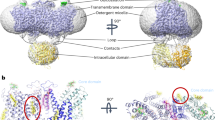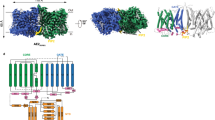Summary
The interaction between chloride and the anion transport inhibitor DNDS (4,4′-dinitro stilbene-2,2′-disulfonate) at the external anion binding site of the human erythrocyte anion transporter was examined by two techniques: a) chloride tracer flux experiments in the presence of varying concentrations of DNDS, and b) DNDS equilibrium binding experiments in the presence of varying concentrations of intracellular and extracellular chloride, Cl i and Cl o . DNDS inhibited competitively the Cl o -stimulated chloride efflux from intact red cells at 0°C and pH 7.8 with an inhibitor constant of 90nm. Under the same conditions DNDS bound reversibly to one class of binding sites on intact cells with a capacity of 8.5×105 molecules/cell. Cl o competitively inhibited DNDS binding with an inhibitor constant of 6mm. In the absence of Cl o the DNDS binding constant was 84mm. The competition between chloride and DNDS was also tested in nystatintreated cells in which Cl o always equaled Cl i . Under these conditions the values of the DNDS binding constant and the chloride inhibitor constant were significantly larger. All these data were in quantitative agreement with a single-site, alternating access kinetic scheme with ping-pong-type kinetics that we have previously developed for modeling chloride exchange transport. The data also served to rule out special cases of an alternative two-sited sequential-type kinetic scheme. DNDS binding experiments were also performed at 10 and 20°C. We found that neither the DNDS binding constant nor the Cl o inhibitor constant were significantly changed compared to 0°C.
Similar content being viewed by others
References
Barzilay, M., Cabantchik, Z.I. 1979a. Anion transport in red blood cells. II. Kinetics of reversible inhibition by nitroaromatic sulfonic acids.Membr. Biochem. 2:255–281
Barzilay, M., Cabantchik, Z.I. 1979b. Anion transport in red blood cells. III. Sites and sidedness of inhibition by highaffinity reversible binding probes.Membr. Biochem. 2:297–322
Barzilay, M., Ship, S., Cabantchik, Z.I. 1979. Anion transport in red blood cells. I. Chemical properties of anion recognition sites as revealed by structure-activity relationships of aromatic sulfonic acids.Membr. Biochem. 2:227–254
Brahm, J. 1977. Temperature-dependent changes of chloride transport kinetics in human red cells.J. Gen. Physiol. 70:283–306
Cabantchik, Z.I., Knauf, P.A., Rothstein, A. 1978. The anion transport system of the red blood cell. The role of membrane protein evaluated by the use of “probes”.Biochem. Biophys. Acta 515:239–302
Cabantchik, Z.I., Rothstein, A. 1972. The nature of the membrane sites controlling anion permeability of human red blood cells as determined by studies with disulfonic stilbene derivatives.J. Membrane Biol. 10:311–330
Cabantchik, Z.I., Rothstein, A. 1974. Membrane proteins related to anion permeability of human red blood cells. I. Localization of disulfonic stilbene binding sites in proteins involved in permeation.J. Membrane Biol. 15:207–226
Cass, A., Dalmark, M. 1973. Equilibrium dialysis of ions in nystatin-treated red cells.Nature, New Biol. 244:47–49
Dalmark, M. 1975. Chloride transport in human red cells.j. Physiol. (London) 250:39–64
Dalmark, M. 1976. Effect of halides and bicarbonate on chloride transport in human red cells.J. Gen. Physiol. 67:223–234
Dalmark, M., Wieth, J.O. 1972. Temperature dependence of chloride, bromide, iodide thiocyanate and salicylate transport in human red cells.J. Physiol. (London) 224:583–610
Dix, J.A., Verkman, A.S., Solomon, A.K., Cantley, L.C. 1979. Human erythrocyte anion exchange site characterized using a fluorescent probe.Nature (London) 282:420–422
Fairbanks, G., Steck, T.L., Wallach, D.F.H. 1971. Electrophoretic analysis of the major polypeptides of the human erythrocyte membrane.Biochemistry 10:2606–2617
Fröhlich, O., Gunn, R.B. 1980. Chloride transport kinetics of the human red blood cell studied with a reversible stilbene inhibitor.Fed. Proc. 39:1714
Fröhlich, O., Gunn, R.B. 1981. Binding of cis and trans isomers of 4,4′-dinitrostilbene-2,2′-disulfonate (DNDS) to the erythrocyte anion transporter.In: Advances in Physiological Sciences. Vol. 6: Genetics, Structure and Function of Blood Cells. S.R. Hollán, G. Gárdos, and B. Sarkadi, editors. pp. 275–280. Pergamon and Akadémiai Kiadó,
Funder, J., Tosteson, D.C., Wieth, JO. 1978. Effects of bicarbonate on lithium transport in human red cells.J. Gen. Physiol. 71:721–746
Grinstein, S., McCullough, L., Rothstein, A. 1979. Transmembrane effects of irreversible inhibitors of anion transport in red blood cells. Evidence for mobile transport sites.J. Gen. Physiol. 73:493–514
Gunn, R.B. 1979. Transport of anions across red cell membranes.In: Transport Across Biological Membranes. Vol. II of Membrane Transport in Biology. G. Giebisch, D.C. Tosteson, and H.H. Ussing, editors. pp. 59–80. Springer-Verlag, Berlin
Gunn, R.B., Fröhlich, O. 1979. Asymmetry in the mechanism for anion exchange in human red blood cell membranes. Evidence for reciprocating sites that react with one transported anion at a time.J. Gen. Physiol. 74:351–374
Halestrap, A.P. 1976. Transport of pyruvate and lactate in human erythrocytes. Evidence for the involvement of the chloride carrier and a chloride-independent carrier.Biochem. J. 156:193–207
Hunter, M.J. 1971. A quantitative estimate of the non-exchangerestricted chloride permeability of the human red cell.J. Physiol. (London) 218:P49-P50
Hunter, M.J. 1977. Human erythrocyte anion permeability measured under conditions of net charge transfer.J. Physiol. (London) 268:35–49
Jennings, M.L. 1980. Apparent “recruitment” of SO4 transport sites by the Cl gradient across the human erythrocyte membrane.In: Membrane Transport in Erythrocytes. Alfred Benzon Symposium 14. U.V. Lassen, H.H. Ussing, and J.O. Wieth, editors. pp. 450–463. Munksgaard, Copenhagen
Jennings, M.L., Passow, H. 1979. Anion transport across the erythrocyte membrane, in situ proteolysis of band 3 protein, and cross-linking of proteolytic fragments by 4,4′-diisothiocyano dihydrostilbene-2,2′-disulfonate.Biochim. Biophys. Acta 554:498–519
Kaplan, J.H., Passow, H. 1974. Effect of phlorizin on net chloride movements across the valinomycin-treated erythrocyte membrane.J. Membrane Biol. 19:179–194
Kaplan, J.H., Scorah, K., Fasold, H., Passow, H. 1976. Sidedness of the inhibiting action of disulfonic acids on chloride equilibrium exchange and net transport across the human erythrocyte membrane.FEBS Lett. 62:182–185
Knauf, P.A. 1979. Erythrocyte anion exchange and the band 3 protein: Transport kinetics and molecular structure.Curr. Top. Membr. Transp. 12:249–363
Knauf, P.A., Fuhrmann, G.F., Rothstein, S., Rothstein, A. 1977. The relationship between anion exchange and net anion flow across the human red blod cell membrane.J. Gen. Physiol. 69: 363–386
Knauf, P.A., Rothstein, A. 1971. Chemical modification of membranes. I. Effect of sulfhydryl and amino reactive reagents on anion and cation permeability of the human red blood cell.J. Gen. Physiol. 58:190–210
Knauf, P.A., Tarshis, T., Grinstein, S., Furuya, W. 1980. Spontaneous and induced asymmetry of the human anion exchange system as detected by chemical probes.In: Membrane Transport in Erythrocytes. Alfred Benzon Symposium 14. U.V. Lassen, H.H. Ussing, and J.O. Wieth, editors. pp. 389–403. Munksgaard, Copenhagen
Ku, C.-P., Jennings, M., Passow, H. 1979. A comparison of the inhibitory potency of reversibly acting inhibitors of anion transport on chloride and sulfate movements across the human red cell membrane.Biochim. Biophys. Acta 553:132–141
Lepke, S., Fasold, H., Pring, M., Passow, H. 1976. A study of the relationship between inhibition of anion exchange and binding to the red blood cell membrane of 4,4′-diisothiocyanostilbene-2,2′-disulfonic acid (DIDS) and of its dihydro derivative (H2DIDS).J. Membrane Biol. 29:147–177
Passow, H., Kampmann, L., Fasold, H., Jennings, M., Lepke, S. 1980. Mediation of anion transport across the red blood cell membrane by means of conformational changes of the band 3 protein.In: Membrane Transport in Erythrocytes. Alfred Benzon Symposium 14. U.V. Lassen, H.H. Ussing, and J.O. Wieth, editors. pp. 345–367. Munksgaard, Copenhagen
Rao, A., Martin, P., Reithmeier, R.A.F., Cantley, L.C. 1979. Location of the stilbenedisulfonate binding site of the human erythrocyte anion exchange system by resonance energy transfer.Biochemistry 18:4505–4516
Saltiel, J., D'Agostino, J., Megarity, E.D., Metts, L., Neuberger, K.R., Wrighton, M., Zafiriou, D.C. 1973. The cis-trans photoisomerization of olefines.Organ. Photochem. 3:1–113
Shami, Y., Rothstein, A., Knauf, P.A. 1978. Identification of the Cl− transport site of human blood cells by a kinetic analysis of the inhibitory effects of a chemical probe.Biochim. Biophys. Acta 508:357–363
Ship, S., Shami, Y., Breuer, W., Rothstein, A. 1977. Synthesis of tritiated 4,4′-diisothiocyano-2,2′-stilbene disulfonic acid ((3H)DIDS) and its covalent reaction with sites related to anion transport in red blood cells.J. Membrane Biol. 33:311–324
Verkman, A.S., Dix, J.A., Solomon, A.K. 1981. Thermodynamics of stilbene binding sites on human red cell band 3.Biophys. J. 33:48a
Wilkinson, G.N. 1961. Statistical estimation in enzyme kinetics.Biochem. J. 80:324–332
Author information
Authors and Affiliations
Rights and permissions
About this article
Cite this article
Fröhlich, O. The external anion binding site of the human erythrocyte anion transporter: DNDS binding and competition with chloride. J. Membrain Biol. 65, 111–123 (1982). https://doi.org/10.1007/BF01870474
Received:
Revised:
Issue Date:
DOI: https://doi.org/10.1007/BF01870474




